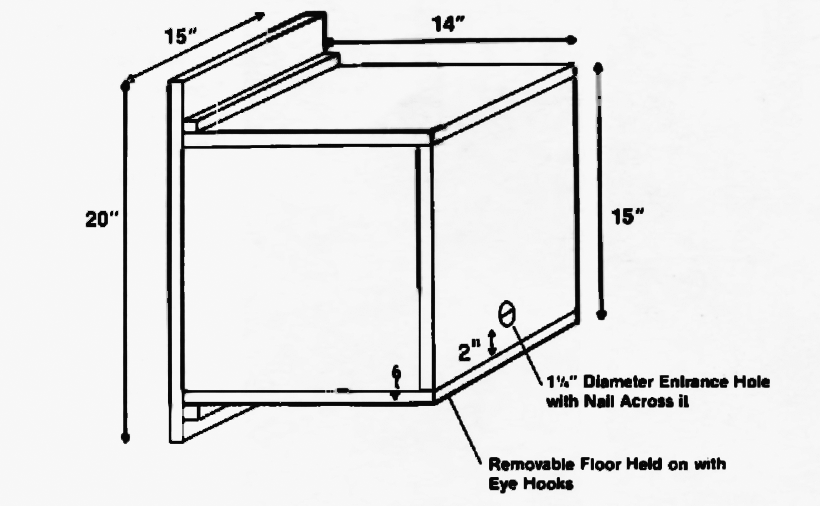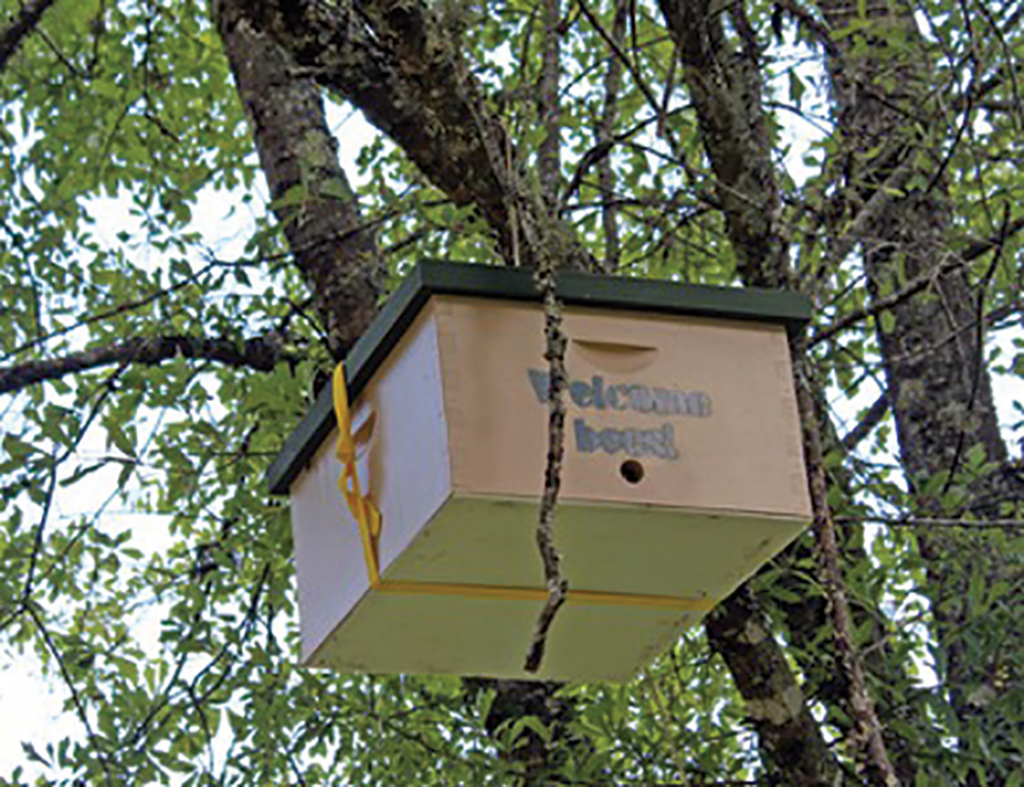A comfortable apiary for both bees and beekeepers.
Bait hives in the apiary.
Odds and Ends – What’s with bees and coffee?
A hive stand photo gallery.
For the Brand New Beekeeper – Five ways to keep (most) colonies alive.
A comfortable apiary site
Go ahead. Give it your best shot. Google Earth my apiary and you will only see tree canopies and shade. The fence takes care of most views, and I hope the canopy precludes aerial shots. It ain’t pretty. I try to keep it hidden.
I do have the best of intentions, but I always seem to suffer from confusion and delay. Therefore, I do not give tours of my apiary; but one day I will and I am working toward that goal. In previous articles, I have offered a few suggestions that describe what modern apiaries should include. For those of us who are not keeping beehives on rooftops, who are not on a balcony in the inner city, or who only have limited options on where to set hives, I am exploring trying to implement the following features in my typical backyard apiary.
Seasonal sogginess
At this very moment, Winter snow has melted. Abundant rain has come time and again. My apiary is a soggy mess. I mean, I am talking using 14″ high muck boots. As one would expect, as I walk hither and yon, the sod gives way until I am walking in a soggy trench.
I need advice and/or opinion. I could put down large quantities of mulch. I have done this in a small area now and it seems to help. Should I haul in truckloads of mulch and spread every season? A gravel pad? That would be difficult on which to walk and impossible to use a hand truck. Old fashioned walk planks made from treated lumber? Possibly, but seems primitive. A large cement slab? That’s expensive; plus I would have to move my bees out while the work was done and then I am committed to that area only. Drainage tiles? Yeah, right. That’s not going to happen.
I can’t move the yard – mainly because it’s where I want it. There are other factors to consider, and I have already installed a blockade fence. I guess I am going for a combination of solutions. In a perfect world, I would heavily mulch walking paths while installing small cement pads (3′ x 3′?) on which to set my hives. As I asked above, what have some of you done?
Hive stand foundations
I am not an accomplished cement worker, but I think I would like to put down small, square cement slabs that I described above. Why? For my entire beekeeping life, I have put hives wherever ñ usually on cement blocks. As seasons past, they would tilt and settle. At a recent WV Tri-State Beekeepers Association session, a beekeeper told me to use a tractor-powered auger to dig holes to get below the frost line in order to put in a level, smooth slab on top of the holes. You people with experience in such matters, how could I put down leveled, stable slabs in my yard? Would paver bricks work? In previous articles, we have discussed hive stands. Now I would like hearing what you have used to put the hive stands on.
Shade
I would like for my yard to be partially shaded. Through no foresight of mine, my apiary is partially covered by evergreen tree shade and shadows ñ but not in deep shade. So one of my desired apiary features are in place. The shade is great in the summer, but I worry sometimes that the shade hampers my bees during the occasionally bright winter day. For beekeepers in small hive beetle areas, it is felt that bright sunlight exposure inhibits the beetles. In such instances, shade could work against the bees. (But it sure is going to hot in that southern sun.)
A work table
I would like to have a pressure-treated worktable in my apiary. I suppose it will simply be a picnic-type table, but I am wondering if the greenhouse industry has table designs that would work better. I frequently photograph my bees for you. I need a place to lay out my camera equipment so that it is available and not scattered. But I also need a table for abundant bee reasons. I have recently lost a beloved hat. I do that about once every two years. A table also becomes a central site for hats, pocketknives, mobile phones, notebooks – everything. Why has someone not designed a “beeyard” table? Maybe a picnic table is the best design.
Energize and connect the yard
My following comments are not for everyone ñ probably not even appropriate for most of us, but I want to put the following suggestions on my bee bucket list.
I want my yard electrically energized with outlets in various places in the yard. Electrically heated bottom boards are on the horizon. Security cameras could be installed. Exterior lighting would allow bees to be manipulated at night (I’ve never seen that done, but I think it would be interesting.) I would like water in the yard. I have considered putting in a rain barrel filled with down spouting on a small storage barn that is nearby, but an actual pressurized facet would be lovely. I have already made necessary modifications to my home network to reach my bee yard. In the near future, I hope Wi-Fi powered hive scales and other such electronic devices will continue to modernize my yard.
This is truly a dream . . .
I would like to install a smallish landscape pond. I’m referring to one of the plastic tub-type plastic units that avoid the complications of larger ponds that raise safety issues for neighboring children. I see them all the time at home building supply companies. I know that reliable water supplies are not a problem for many of you, but water is an issue for my neighbors and me. Are there any stories from you on this concept?
Bait hives
At erratic points during my beekeeping years, I have put out bait hive boxes. This is a reasonably easy addition to my yard. I do hope that it will be an attraction for swarms departing from my hives. I have written several times describing the angst a beekeeper feels as their bees depart for points totally unknown.
Many of you have stories about the surprise of finding a swarm that had occupied unused bee equipment. Yes, I have some stories of my own. I have made some simple boxes just because I had the lumber. Additionally, I have used retired nuc boxes and aged regular hive equipment.
As I worked on my thoughts, I have freely referenced Seeley’s bait hive work published many years ago. The booklet is clear and filled with recommendations. It can be found by searching the Internet with the search parameters, bait hives Seeley or possibly bait hives Cornell. So long as the present link is active, you can access it at: http://tinyurl.com/bait-hives .
The general recommendations contained in the Cornell Brochure (Extension Bulletin #187) are summarized below.
Recommendations for Bait Hive Design
- Height: about 15″ above the ground
- Well shaded, but highly visible
- Okay if near parent colony
- Circular opening of about 1-1/4″
- However, it does not have to be circular so long as the entrance is about 1-1/2 – 2 square inches
- Entrance should be near the bottom
- Ideally face to the South, but not a requirement
- Trap box should be about 40 liters or about the size of 10-frame hive body
- Box shape is not critical
- Box should be dry and tight
- New lumber probably not best
- Beeswax odor is helpful. Be careful when using old combs. Lures smelling of lemon grass are helpful.
Many of you have developed you own procedures. Though pulp boxes and other designs have been available, it is common for beekeepers to develop a bait hive system that is convenient for them.
Dr. John Hurst, Master Beekeeper, is a lifelong beekeeper who has used bait hives for many years. These units hang in various nearby trees near the perimeter of his neat research apiary. He normally has positive results and traps a few swarms every year. These traps are a consistent aspect of his management program.
I have been recommending that a nucleus hive be a routine part of anyone’s apiary who has more than five or so colonies. Nucleus hives are useful in too many ways to discuss here. In a similar fashion, bait hives positioned near an apiary are essentially nucleus “traps.” Any bees that move into the bait hive will be transferred to some type of standard equipment. Bait hives and their relative, nucleus hives, should be important components of the modern apiary.
For the Beginner
All beekeepers want to keep their bees alive throughout the year. But it is presently normal for some percentage of bees to die each season. Commonly, colonies die during Winter, but during the remaining three seasons of the year, they can go queenless or be robbed by neighboring colonies. Even, in the wild, colonies commonly die. So, there it is . . . even with the beekeeper’s best efforts, some colonies will occasionally die. It is normal and expected that concerned beekeepers will do all they can to keep colonies alive – especially now when bees have become expensive and somewhat difficult to acquire. All beekeepers (especially me) should consider the common five points that are presented below.
- Suppress Varroa populations – Do something to suppress Varroa populations, and do it regularly. If you feel that you do not have to treat, then at least regularly check your mite population. Even a small population can vector damaging viruses. Of course, all other diseases should be monitored and treated.
- Nutritional needs – In my opinion, it is presently a risk to categorically assume that your colonies can locate all the food resources ñ including trace elements and mineral salts ñ needed to routinely keep the colony thriving. Pollen supplements have been steadily improving in recent years. Providing supplemental protein and carbohydrates is very nearly a common beekeeper task. If the apiary is large ñ probably 30+ colonies and food stores are consistently low, consider a second yard a distance away. In some way, work with your bees to be sure they accumulate necessary wholesome food supplies. The bees’ natural world is not always very natural.
- Queen management – Though tricky even for the most experienced beekeepers, monitor the colony’s queen. Yes, the colony can produce its own, but that procedure should only be used in a dire bee emergency. Would it not be great if a colony had a queen and a vice queen? But that’s not how it is in the colony life. The queen can go at any time, and the time it happens can be very bad for the colony’s survival. I know, I know. Queens are expensive and sometimes not much better than the queen being replaced. Even so, monitor the queen’s performance and make changes before an outright colony emergency occurs. And it is true — you are usually simply making your best guess. (At this point, remember the nucleus colony I suggested you have operational. That could be your “vice queen” in waiting.)
- Winter preparation – Even in warm climates with mild winters, much (most?) of the season’s efforts are to prepare for the time when no food reserves are coming in. The bees survive on their stored larder. This Winter preparation is directly related to nutritional needs above. Additionally, hive equipment should be correctly positioned, windbreaks provided, and entrances reduced. The harsh fact is that we are wintering the colony in an artificial cavity filled with comb appliances (frames) that are foreign to the natural biology of wintering bees. As much as we can, we should make the wintering colony comfortable in our hives. Provide food and do what you can to protect the colony during the cold season.
- Stay ahead of swarming – I have personally suffered the frustration of a swarm leaving. Know this ñ at some point, a swarm will get by you. Swarming is an entirely natural bee occurrence. A drastic option that could be done is to split the powerful colony into smaller colonies. If you do not want extra numbers, the splits can be recombined. Yes, queens will be a problem. Should you buy them or is this a case where natural queens are okay. Splitting the colony may also reduce Varroa populations. Maybe the bait hives I discussed above could come into play and save some swarms for you and me. In this list, swarming is an annoyance from which the colony may recover and continue to thrive ñ or not. Try to control swarming, but realize that the previous four points are much more important. Try to win more than you lose.
Odds and Ends
Coffee grounds and bees
What do you know about coffee grounds and bee foragers? Many years ago, (I hope you are reading) a beekeeper sent me a short video of foraging honey bees going crazy over coffee grounds. I could not explain the intensity then or now. At the WV meeting I recently attended, O. Baker, a local beekeeper suggested putting coffee into the water source to help the bees find it. On the Internet, in years past, there has been an intensive discussion about the rabid interest that bees have in coffee grounds. The simple search parameters of honey bees and coffee grounds will keep you reading for several hours. As is so typical, there are also some bunk answers included.
Photo gallery of beekeeper hive stands
After I discussed the various stands on which we set our colonies, you responded in earnest. I was caught unawares and initially did not do a proper job of saving photos and communications. I recovered as best I could and have posted some of your photos at the following Internet site. If I have misspelled names or have omitted a design that you sent to me, let me know2.
http://tinyurl.com/hive-stands
A Thank You…
Thanks to the Tri-State Beekeepers Association3 for hosting John Grafton and me. It was a great time, and Oglebay Resort and Conference Center was a beautiful place for a bee meeting. Thank you Steve and John.
I have heard that the Jefferson County Beekeepers Association4 in Alabama reviews this BC article each month. I have not heard how I have fared. Hmmm. I have enjoyed my few visits there and appreciate you having a look at this column.
Until next month . . .
Dr. James E. Tew, State Specialist, Beekeeping, The Alabama Cooperative Extension System, Auburn University; Emeritus Faculty, The Ohio State University. Tewbee2@gmail.com; http://www.onetew.com; One Tew Bee RSS Feed (www.onetew.com/feed/); http://www.facebook.com/tewbee2; @onetewbee Youtube: https://www.youtube.com/user/onetewbee/videos
2Some users prefer the original unmodified URL.
That address is:
https://onetewbee.smugmug.com/Hive-Standsfor-Beehives/n-WZM9zp/i-6BG6MjV
3 http://tristatebeekeepers.com/node/45
4 https://www.facebook.com/Jefferson-County-Beekeepers-Association-11794489873/











